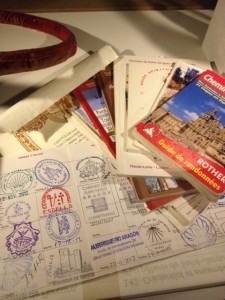Travel in the Middle Ages/Voyager au Moyen Âge – Musée de Cluny, Paris
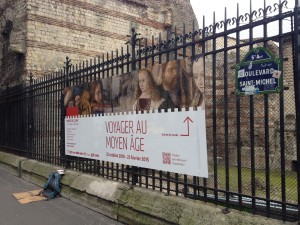
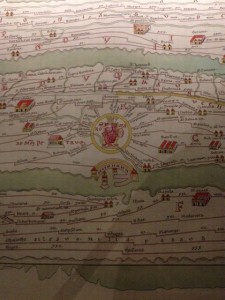
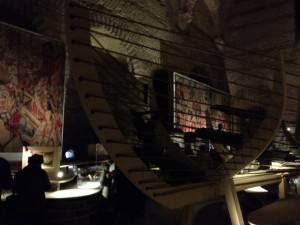
Some of these motivations and considerations will be among the preconceptions of many a visitor. For a start, we know that travel was more difficult and dangerous, that their maps did not look like our maps, and that pilgrimages and Crusades featured heavily in the reasons for leaving home. Maps are taken as the starting point. The visitor’s entry point into the mindset of the medieval traveller is a selection of maps, including the Peutinger Map which shows travel routes through the Roman Empire, or others which show the world in the form of a T, with Jerusalem at the centre. It is apparent from the outset, therefore, that the medieval travellers we are dealing with saw their world according to the resources available to them, and also according to where they fitted into a political, financial or religious framework. This is reinforced by the exhibition text: while your average peasant knew the pope was in Rome (or Avignon), he had little idea of what was past the next village. A prince might know a bit more, and a merchant certainly knew what his trade routes were. Even for voyages which were not religious in nature, a certain amount of faith was required to undertake them.
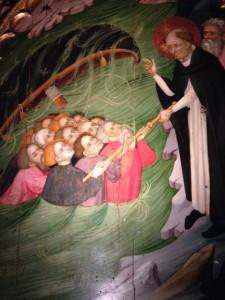
Where I found the exhibition to be very interesting was where it went beyond what I expected the medieval motivations for travelling to be. Crusades and pilgrimages, fine. Merchants trading goods, yes, some of that too. Travel to maintain social visibility, for example for princes maintaining control of their lands, wouldn’t have come to mind as easily. Rouleaux des morts, now here is something interesting! It turns out that when an abbot or prior died, the details would often be written on a parchment scroll which was then taken to all the other religious communities the dearly departed was in contact with. The notables there would then add their commitments to prayer or condolences, and the journey would then continue. The fact that the scrolls were gradually added to allows the journeys, some of which lasted more than a year and crossed much of Europe, to be pieced together, and it transpires that they didn’t always make sense, with to-ings and fro-ings and doubling back. A result of a poor knowledge of geography based on a theocratic map, or some other reason? Either way, I found the whole process to be fascinating. Likewise the idea that we can track artists’ travels by their output, but that their biographies and the means and motivations are much harder to decipher. I did like that we know that artist Albrecht Durer went to Venice to complain about Giorgio Vasari copying his works, in an early type of copyright enforcement.
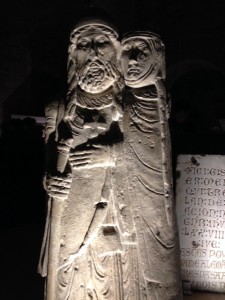
Another thing which the curators did very well was to consider how the different types of travel in the Middle Ages are reflected in the physical record, and what the reasons for this are. Despite the immense numbers of crusaders, physical objects directly related to their travels are few and far between. I did like the sculpture of the husband and wife reunited after many years during which she refused to believe he was dead (Odysseus and Penelope anyone?). But aside from some crosses, and of course the ruins throughout the Middle East, there is little in the way of tangible evidence to be displayed in a museum context. Much like the ships and boats medieval travellers often used, where sometimes a pile of nails is all that remains. Or the material evidence of those below the level of princes, abbots and merchants, who had precious little in the way of material goods to begin with. By discussing the availability or lack of different categories of object, the curators manage to turn a potential pitfall of their topic into a subject for education and reflection.
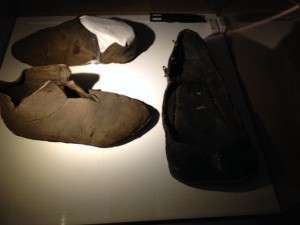
I have only one small criticism, and that is that the links between medieval modes and motivations of travel and our modern journeys seemed a bit of a stretch. There may have been information for pilgrims centuries ago, but the similarities with modern travel guides are slight. And while some companies continue to use the image of protective saints, for most travellers this is not for the purposes of genuine heavenly protection. Or maybe it’s just that I found the differences more interesting than the similarities. The idea of monks traipsing across Europe with condolence parchments to be filled out is certainly one that will stay with me, as will the image of the delicate Iranian glass depicting a bird, found in a Viking’s tomb. It’s the courage and spirit of adventure which is central to the attractiveness of medieval travel, and this exhibition is at its best when it evokes this in unexpected ways.
